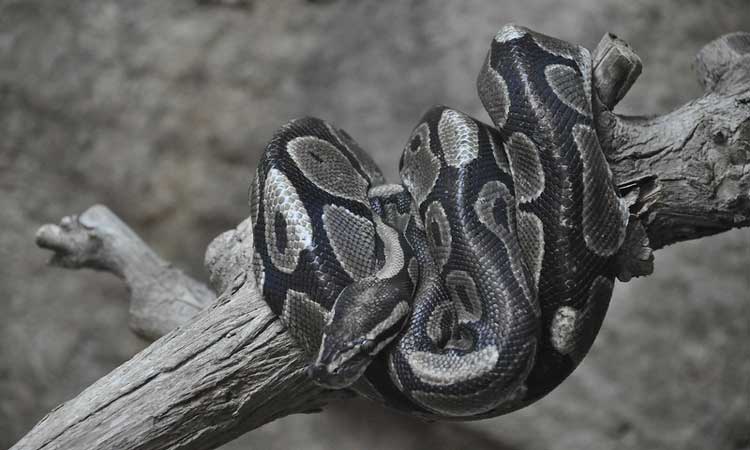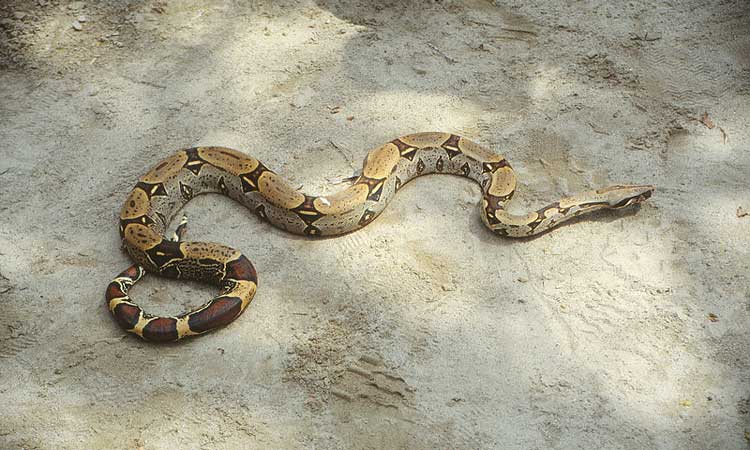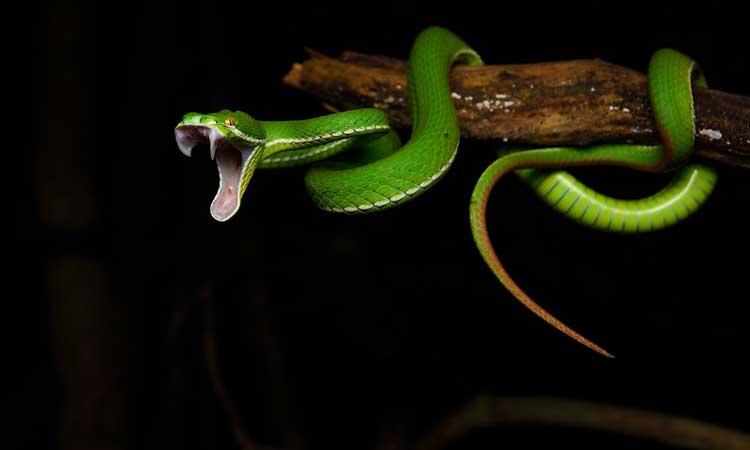There are an immense variety of snakes that you can make your pet. The most crucial part is to find the right one for petting. When we say the right one, it means how friendly it is, how compatible can it be, how long it can survive in captivity, what the costs and benefits of providing good care are involved.
As beginners, certain species of snakes are best to opt for compared to the experienced owners. Some snakes can be difficult to handle and care for when they are reluctant like the wild-caught ones. They are considered to be the worst pet snake for beginners or new to the snake-owning hobby.
There are others that are venomous and not very gentle with humans while handling them.
Other problems can be with their eating habits or growth issues. In contrast, the best pet snakes such as the Ball python, Gopher snake, Carpet python, and many others like them, have a better camaraderie with humans and are more docile and calmer in nature.
This group of snakes is known to be the best pets as long we administer to its daily needs, such as food and water, a good enclosure with all its requirements, regular medical treatment, and care.
How Friendly Is Your Snake? Good Snake Vs Bad Snake
If you have any options of making a pet snake it is always wise to know its nature and characteristics. You should know its behavior and reaction towards others as well as the owner yourself.
They could be good pets as long as it is isolated and captive in their enclosures but what happens when you are not around and a family member or friend comes by. This is a concern for many pet owners.
Usually, snakes are friendly when they are submissive and feed regularly when food is given.
Here are some signs of friendliness among pet snakes:-
- Calm and unhurried movements
- Takes food from you or while you are present
- Will calmly explore you when holding it
- Comes to the front of its enclosure when you are present
- Rests on you
- Explores when you are nearby
- Behaves differently with you
These signs indicate that the snake is fond of you. But what happens when another person comes in front?
Snakes have a sense of differentiating by smell. They behave quite differently from others from their owner. It may feel unwilling to come forward or take food from a different person.
This is because they are more comfortable with the person, they have gotten more time to spend with. Possibly it will overcome this attitude of indifference if the new person has made it a habit of being there daily or often.
Here are the signs when your snake is not friendly with you or another person:-
- Moves quickly away to take cover
- Refuses to take food from you or when around
- Hissing noises, snapping or shaking the end of the tail
- Whirling to get out of your hands or grip
- Tasting the air or flattening its body when you or the person is around
- Forming into an S-shaped position when you try to pick them up by holding
- It seeks shelter when you are around or does not explore its surrounding like it usually does
The Worst Pet Snakes
Here are some of the snakes that are difficult to keep as pets or captive in your homes: –
1. African Rock Pythons

The African Rock Python is a huge snake that grows up to 20 feet or more. They require a lot of food like, rabbits or chickens and they have an irritable temperament which makes it quite difficult for the owners. These snakes are usually wild-caught which is one reason they don’t make a good pet. And even if they are bred in captive they have a chance of carrying disease or parasites.
2. Reticulated Python
The reticulated python is another long-grown python that can grow up to 32 feet especially when wild-caught. This python is found in the wild regions of mainland Asia and the Philippines. They are feared for their ability to kill humans other than attacking farm animals. There are a lot of breeders who still keep this species as it is part of their hobby despite knowing of the dangers.
3. Boa Constrictors

Boa constrictors are benign in nature but they could become defensive if threatened and even bite. They are found in the tropical forests of Central and South America. In order to keep the boa constrictor captive as a pet, it will take some effort to provide them the similar kind of habitat that they were accustomed to. And not everyone is ready to take that option.
4. Burmese Python
Although the Burmese python is one of the common species taken as a pet they are quite long and sometimes hard to maintain. This python grows up to 20 feet long. When in captive they reproduce very quickly and the owner might end up with hundreds of eggs. Often these eggs need to be released into the wild. This could end up in invasive breeding populations and become hard to control.
5. Green Anaconda
The green anaconda is another constrictor that has the same problem of keeping as a pet as many large constrictors. They are short-tempered and need to be provided with large amounts of food. Apart from its length, it is one of the heaviest among all snakes, weighing up to 485 pounds. Not only its weight but the expenses of providing it with food and care would make it the hardest choice. The green anaconda also needs to spend a long time in water and so needs to be given a proper place like a large tank of water which is difficult to maintain.
6. Wild-Caught Ball Python
The wild-caught ball python is a challenge to keep compared to the in-bred captive ball pythons that are commonly kept as pets. The wild-caught pythons are having an ill temper and may lose their control sometimes. They also have a tendency to carry parasites and are often difficult to feed.
7. Flying snakes
The flying snakes have a difficult diet and habitat to maintain. As the name implies it does like jumping off high grounds to lower grounds which looks like flying and landing. It needs to have a place to glide and move around as it does originally in its native area. These snakes are found in Southeast Asia and they glide from tree to tree as they move through their territory. Flying snakes eat lizards mainly and they are also known to be slightly venomous which is one good reason not to keep them as pets.
8. Mud Snakes
This snake is found in the Southern United States. Mud snakes are comparatively calm and gentle but their only problem is they eat very limited and picky eaters. Mud snakes eat some amphibians of their choice often refuse to eat while in captivity. Being picky about their food is deemed difficult for the owners to maintain.
9. Black Racers
Although this constrictor is beautiful to look at they have a reputation of becoming violent when reacting to strangers. Most black racers that are caught and sold are wild-caught. These kinds are defensive. Also, they are not good at resisting handling and do not calm down easily. They like to move around their territory with complete freedom which is another drawback for owners who want to keep them captive in cages.
Kinds of Worst Snakes And Their Behaviors
There are several kinds of snakes that do not qualify for pets and pose a lot of difficulty in maintaining. It is very important to justify and choose the right kind of species before facing any trouble in the homestead area.
Aggressive Snakes– Snakes that are aggressive have no mercy towards anyone they come in front of. It will bite without knowing and its venom is lethal. Most victims who are not treated early will succumb to death. The saw-scaled viper is one of these snakes that have caused most human deaths according to scientists.
Unfriendly Snakes– There are several snakes that are not easy to keep as pets and feed. They often require special attention and are not willing to come forward when any other people are around. This happens to snakes that are wild-caught and not used to being captive. They will behave irritably and show an unwillingness to eat. The wild-caught ball python is one example. This kind of snake will not be very easy to make comfortable at home.
Snakes That Bite– Snakes have always tended to bite humans but there are a few exceptions. A well-maintained and in-bred snake shows much more friendly behavior than wild-caught snakes. There are many of these that bite when feeling threatened. Pit vipers have the most venomous bites and 50% of these are rattlesnakes. They should never be bothered and better left alone. Even when dead snakes can bite and so it is wise to not handle these snakes.
Bad Beginners– Some snakes have a hard time adjusting to their captive surroundings and show unwillingness for coming forward. These are species that have been caught from the wild and brought in for living in an enclosure. In these cases, it takes a longer time or even never ends up friendly with its owner. Boa constrictors are such an example. This snake has an attitude that you cannot predict often. If you want to keep them captive then it may cost a lot of time and maintenance for the owner.
Venomous Snakes– Venomous snakes are the most challenging and dangerous ones to deal with. Thousands of people have been bitten by venomous snakes in the US each year. Medical care needs to be taken immediately or else this number would be rising. Some of the most venomous snakes are copperheads, rattlesnakes, cottonmouths/ water moccasins, and coral snakes to name a few. Unless a person is trained, he or she should never come across these kinds of snakes.
Summery
Choosing the right snake is the hardest part when you want to keep a pet snake at home. The right choice lies among a number of factors such as, whether it is venomous, whether it tends to bite, what kind of feeding and nurturing is required, how safe it is around your home and other people. It is best to take advice from professionals and trained owners who have years of experience in handling and knowing snakes, as nobody would want to end up bringing home the worst pet snake. It is always wiser to learn a bit and do your research before.

